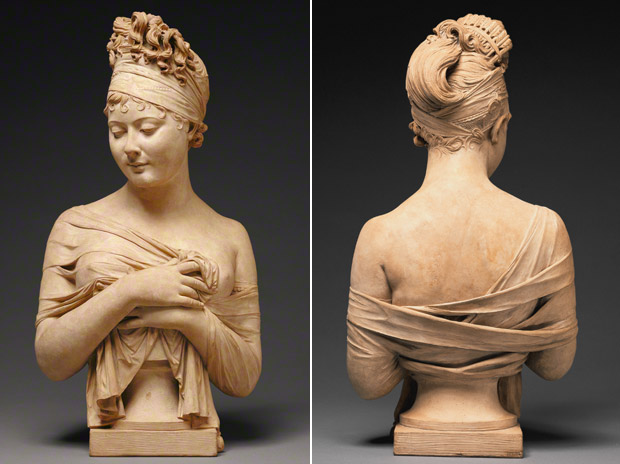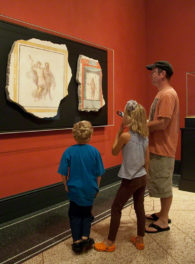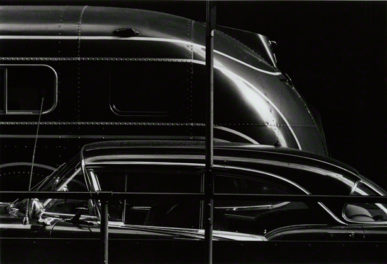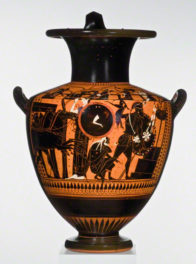Can an artist do justice to a beautiful woman?

Bust of Madame Recamier, Joseph Chinard, about 1801–1802. Terracotta, 24 7/8 in. high. The J. Paul Getty Museum, 88.SC.42
This sensuous terracotta bust by Joseph Chinard captures the elegance and grace of legendary beauty Juliette Récamier, a socialite renowned for her wit and notorious for her love affairs. Holding a diaphanous drapery, she covers up her right breast, but leaves her left bare.
Here, she could be described as coy and coquettish—or demure and reserved. Is she feigning modesty with her downward gaze, or is the reserve genuine? Is the drapery concealing—or revealing?
I wonder how much Mme Récamier orchestrated her own image. No mere beauty, she was intelligent, accomplished, and respected by erudite men and women, from Mme de Staël (who based the heroines of some of her novels on her) to Théophile Gautier (who wrote of her “indescribable attraction, like the poetry of the unknown”). At her own request, replicas of this very bust were given to friends and family members.
What do you think: Is she demure or coquettish? Artless or artful? Does this bust conceal more than it reveals—not only of her body, but of her mind?
Question of the Week is a series inspired by our Masterpiece of the Week tours, offered daily at 4:00 p.m. Featuring an open and upbeat discussion among visitors and gallery teachers, the tours feature a new object and pose a new question each week.




Methinks if she were truly demure, she’d have been covered by more than a diaphanous drapery. Her eyes are downcast, but just look at the curve of that lip. Someone who orders copies of a half-dressed sculpture of herself for friends and family is not what I’d call “reserved”!
Well, Kristine, would you believe the following tale? Legend has it via Mme Récamier’s niece that one day Juliette got the idea that one of the marble versions of this bust, also by Chinard, was rather shocking, so she ordered the lower part of the bust, from the shoulders down, to be changed into a pedestal. Have a look at that bust, which is at RISD. How complex the human psyche is…
I agree with Kristine! But on the other hand, I have trouble with the idea of classifying women into categories — demure (which suggests “proper” and well-behaved) or coquettish (suggests bad/threatening/deceptive).
Can you say more about Juliette Récamier? I know about her famous portrait by Jacques-Louis David, and that a couch was named after her, but what does “socialite” mean, exactly? That’s another loaded word…
Hi Anna,
Juliette Récamier was a fascinating figure of French Directory (1795-1799) and Empire (1804-1814) society. Renowned for her beauty and wit and notorious for her love affairs, she was one of the most famous socialites of her time. I caution even myself at the use of the word socialite…. Mme Récamier was a salonnière, which meant that she directed the discussions around literary, cultural, political themes and got to invite A-Listers of her period to the salon, the center of intellectual activity ini Paris.
Some of her guests were prominent literary and political figures, such as Napoleon I’s brother, Lucien Bonaparte, the writers Benjamin Constant and Chateaubriand, in addition to Prince Augustus of Prussia, the youngest brother of King Frederick II.
To your comment about her being both demure and coquettish, that duality is what makes her so captivating.
I think that Récamier was somewhat controlling of her image. I did a long project on Jacques Louis David years ago, and read that she didn’t care for David’s (unfinished) iconic portrait of her on the couch that now bears her name. She preferred the portrait painted by Gérard – really any work that presented her in a more alluring, flirtatious light. I think the terracotta piece here is rather coy, it’s a feint at modesty, however, one with classical allusions. Think of the nude sculptures of an Aphrodite emerging from her bath caught in the action partially covering her breasts with her arms.
This convention of a society beauty with bared skin doesn’t seem to be all that unusual. I’m thinking of the semi-nude Canova sculpture of one of Napoleon’s sisters as Venus with her golden apple. One could also consider the “lingerie” portraits by Winterhalter of the Empress Elisabeth of Austria and Queen Victoria. They’re both in their white wrappers with hair down, but the paintings were only meant to be seen by their respective husbands. Of course, as the consorts of monarchs, they could never have bared more than their shoulders.
As for Mme Récamier, the image is rather artful on her part. I think that she was as happy to be known for her beauty as her intellect, witness her salons with the leading thinkers of her time.
Oh my. Rushing the typing is never good – of course Victoria was the sovereign herself, Sissy the consort.
It could be the angle or the lighting but I get the impression that she is not looking downward but knowingly over her shoulder as though she feels the gaze of an admirer. The subtle details make all the difference. With little knowledge of either the artist or subject I would have to agree with the comment praising the dual nature of feminine sensuality.
Much intrigue surrounds David’s 1800 iconic portrait of Juliette, which you mention, BMW. Why was it left unfinished? We don’t really know. Perhaps its “noble simplicity” did not please the subject, or perhaps David was working too slowly. He quipped, “Women have their whims, and so do artists…” Whatever the controversy, Mme Récamier then commissioned a portrait from David’s most respected student, Gérard. This work was much to her approval, as you note, BMW, and she gave the painting to her admirer Prince Augustus.
Elijah — what a fascinating observation about her possibly looking away from some unseen admirer! Knowing something about the artist may be interesting. Could it have been the artist himself? Chinard and Mme Récamier had a complex relationship that went beyond patron and artist — they were friends, too. Conceivably by virtue of their common birthplace of Lyon, Chinard most likely met Mme Récamier and her husband Jacques in 1795 upon his visit to Paris to be admitted into the Institut de France. It was at this time that Chinard is believed to have executed his first bust of 17-year-old Juliette, which was followed by larger versions in both marble and terracotta. In fact, Chinard is said to have resided with Mme Récamier upon his return to Paris in 1801 and maintained his friendship with her until his death in 1813.
The whole subject of relationships between artist and subject, as well as inspiration and common bonds has to be the most fascinating aspect of Art History. After reading the last paragraph of your response, Christine, I’m ready to dive into the stacks again.
This is such a beautiful piece. I think there is a lot of middle ground for the analysis. I have to agree with the comments about the dual nature of feminine sensuality. This personifies the ideal (societal view) of what the perfect woman should be…
Very beautiful. Artist can definitely do justice to a woman. Some artist can over justify a woman’s beauty and disposition. I’ve met women in los angeles that are more stoic and uninteresting than any sculpture or statue i’ve ever seen.
Revealing a breast is actually part of the silent pact that many artists refer to when designing the contours of a sculpture…it is a very old chiseled “trick” and accepted in the art circles…so what is wrong with revealing nature? What is wrong with being feminine? Covering up and revealing is a sexual, natural and sometimes innate way women attract attention. And if that is to be conveyed in an art form, well, it is not really a big deal unless the work is a masterfully done work as is this work is.
The title is soooo feminist american woman……outch
In europe we love feminin woman. We don’t love feminist fighting “might be man” woman. In America woman very often dress and behave like man. This is disgusting.
There is and was always a difference between man and woman. And this is good.
Can’t you just enjoy the beauty of a sculpture of a feminin woman ?
I think this piece represents a woman who knows how to portray just the right amount innocence in the seduction of a man. Here you have Mme Récamier revealing just enough to entice, while leaving the rest to the imagination. Its a beautiful sculpture and I’d have to say she is definitely being coquettish. Also, I think that the bust reflects Mmes ability to balance the different aspects of her personality. She was an educated woman who used her sexuality and didn’t repress it.
As a sidenote, Maskulin, it would be better if you left your chauvinist opinions in the backwards society that you claim is European. It would be ignorant to say all of Europe is like you, just like it would be ignorant for you to assume that anyone in an art blog is interested in your taste in women.
Good art asks more questions than it does in giving answers.This truly is a work of art, not only on the part of the artist, but on the part of the sitter as well. I bought a small postcard of The Bust Of Madame Re’camier, on my first trip to the Getty some time ago. Her image is on my screensaver and I have often thought about what both artist and model were thinking when it was made. To my minds eye anyway, that it was a good collaboration between the two.